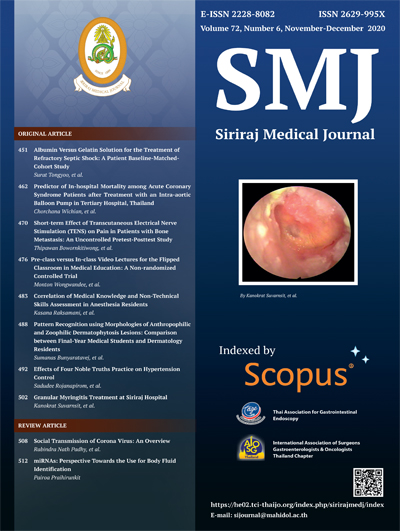Predictor of in-hospital mortality among acute coronary syndrome patients after treatment with an intra-aortic balloon pump in tertiary Hospital, Thailand
DOI:
https://doi.org/10.33192/Smj.2020.62Keywords:
Cardiogenic shock, Acute coronary syndrome, intra-aortic balloon pump, predictors of in-hospital mortalityAbstract
Objective: Intra-aortic balloon pump (IABP), a mechanical hemodynamic support device, had widely been used to treat cardiogenic shock patients for several decades. However, the information about the predictive factors associated with mortality was scarce. This study aims to identify the predictive factors associated with in-hospital mortality in acute coronary syndrome (ACS) patients who performed IABP for their hemodynamic support during admission.
Methods: We conduct a retrospective cohort study design. All admission records of ACS patients with IABP at Suratthani Hospital between October 2015 and September 2019 were retrieved.
Results: Overall 75 ACS patients with IABP insertion were enrolled. Thirty-one patients died during admission, in-hospital mortality was 41.3%. From the multivariable analysis, we identified 3 predictors associated with in-hospital mortality included cardiac arrest at presentation (adjusted OR [aOR]=11.18, 95%CI: 2.42-51.57, P=0.002), a higher number of inotropes or vasopressors (aOR 6.10, 95%CI 1.36-27.24, P=0.018) and Killip class IV (aOR 5.64, 95%CI 1.01-31.39, P=0.048).
Conclusion: ACS patients who required IABP support had high mortality. Cardiac arrest, Killip class IV (cardiogenic shock) at presentation and requiring a higher number of inotropes or vasopressors were independent predictive factors of in-hospital mortality.
Downloads
Published
How to Cite
Issue
Section
License
Authors who publish with this journal agree to the following conditions:
Copyright Transfer
In submitting a manuscript, the authors acknowledge that the work will become the copyrighted property of Siriraj Medical Journal upon publication.
License
Articles are licensed under a Creative Commons Attribution-NonCommercial-NoDerivatives 4.0 International License (CC BY-NC-ND 4.0). This license allows for the sharing of the work for non-commercial purposes with proper attribution to the authors and the journal. However, it does not permit modifications or the creation of derivative works.
Sharing and Access
Authors are encouraged to share their article on their personal or institutional websites and through other non-commercial platforms. Doing so can increase readership and citations.















